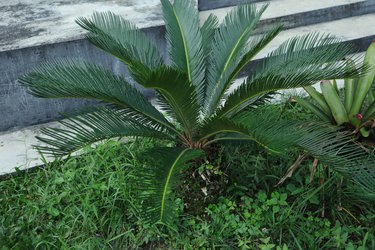
There are more than 2,600 known species of palm trees, which are closely related to grasses and are not true trees. Palm trees grow on every continent with the exception of Antarctica. The height of a palm tree ranges from 200 feet for the world's tallest species to under 10 feet for dwarf varieties used as indoor plants.
World's Tallest Palm Trees
Video of the Day
The Andes mountains of South America are home to the Quindío wax palm (Ceroxylon quindiuense), which is considered to be the tallest palm tree on Earth, with heights up to 200 feet. The Quindío wax palm is Colombia's national tree. The wax of this species was once used to make candles.
Video of the Day
At 100 feet, the Mexican fan palm (Washingtonia robusta), which is native to northern Mexico, also ranks among the tallest palm trees in the world. The Mexican fan palm is closely related to the desert fan palm (Washingtonia filifiera), also known as the California fan palm, which is the only palm that occurs naturally in the western United States. With a typical height of approximately 66 feet but capable of growing even taller, the California fan palm is considered the country's tallest palm tree.
Medium-Sized Palm Trees
Many palm tree species across different genera have heights between 10 and 50 feet. The cabbage palm tree (Sabal palmetto), the state tree of Florida and South Carolina, is approximately 40 feet tall, while the cold-hardy windmill palm (Trachycarpus fortunei) of China has heights between 20 and 40 feet. The foxtail palm (Wodyetia bifurcata) of Australia has a maximum height of 30 feet. The spindle palm (Hyophorbe verschaffeltii), which is almost extinct in its native range in the Mascarene Islands of the Indian Ocean but is cultivated all over the world, has heights between 20 and 25 feet.
On the shorter end of this range are the triangle palm (Dypsis decaryi) of Madagascar and the slow-growing zombie palm (Zombia antillarum), native to the island of Hispaniola, which is shared by the Dominican Republic and Haiti. These species have heights between 10 and 15 feet respectively. They are good small palm trees for gardens. Because it does not exceed 10 feet, the zombie palm is recommended for planting next to one-story homes.
Palm Plants Indoors
If you want to grow palm plants indoors, look for specimens that are around 6 feet or shorter at maturity or that grow slowly enough that you will not have to transfer them outdoors for many years. One such option is the pygmy date palm (Phoenix roebelenii), which usually grows to about 6 feet. It can grow to 12 feet tall, but it grows slowly enough that it's not a concern.
Because of their wide spreads, parlor palms (Chamaedorea spp.), a decor staple in the Victorian era, are a good option if you want to fill a large indoor space. As an added benefit, they require less light than other palms. The cat palm (Chamaedorea cataractarum) is especially easy to grow. Lady palms (Rhapis spp.) are also a popular choice for an indoor palm. The Thailand lady palm (Rhapis subtilis) has a maximum height of 6 feet.
- HGTV: 13 Classic Palm Tree Varieties
- Clemson Cooperative Extension: Palms & Cycads
- Mississippi State University Extension: Palms & Cycads for the Midsouth Landscape
- Clemson Cooperative Extension: Indoor Palms
- NC State Extension: Phoenix roebelenii
- University of Florida IFAS Extension: Washingtonia robusta: Mexican Fan Palm
- California Native Plant Society: Fan Palm
- Global Trees Campaign: Quindío Wax Palm
- University of Florida IFAS Extension: Sabal palmetto: Sabal or Cabbage Palm
- Naples Zoo: Palm Trees
- University of Florida IFAS Extension: Hyophorbe verschaffeltii, Spindle Palm